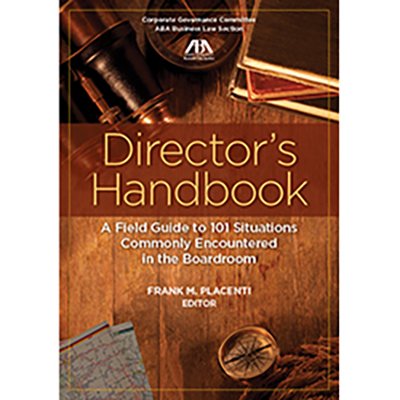In March 2017, I wrote a guest commentary in the ABA Business Law Section’s Corporate Governance Committee publication (Insight) entitled, “The Erosion of Boardroom Lawyering.” In that piece, I observed an incongruity in the U.S. capital markets; that is, a growing number of boardroom lawyers seem fixated upon “box checking” and “culpability avoidance,” whereas stakeholders were laser-focused upon governance excellence. I concluded the piece by stating that: “…to those who are regularly in boardrooms, the gulf between the legends of boardroom lawyering and everyone else is growing… fast.”
 Cue the legends of boardroom lawyering featured in Frank M. Placenti’s encyclopedic Director’s Handbook: A Field Guide to 101 Situations Commonly Encountered in the Boardroom (American Bar Association, 2017).
Cue the legends of boardroom lawyering featured in Frank M. Placenti’s encyclopedic Director’s Handbook: A Field Guide to 101 Situations Commonly Encountered in the Boardroom (American Bar Association, 2017).
Placenti is well-suited to edit and contribute to Director’s Handbook. He chairs the U.S. Corporate Governance Practice at Squire Patton Boggs, he is the founding President and Trustee of the American College of Governance Counsel, and he’s a Vice Chair of the Corporate Governance Committee of the American Bar Association.
The 512-page book is divided into 12 sections, and 101 subsections, and includes content authored by boardroom legal titans like Holly Gregory (Sidley Austin LLP), Robert Bostrom (Abercrombie & Fitch Co.), Mark Easton (O’Melveny & Myers LLP), Lori Zyskowski (Gibson, Dunn & Crutcher LLP), Cheryl Scarboro (Simpson Thacher & Bartlett LLP), and Trevor Norwitz (Wachtell, Lipton, Rosen & Katz).
Praise for Placenti
In his praise for the book, famed Silicon Valley lawyer Larry Sonsini (Wilson, Sonsini, Goodrich & Rosati) observed that: “The Director’s Handbook is an excellent tool to help guide directors… and it provides a litany of questions to assist them in identifying and addressing the many challenges they face.”
To underscore Mr. Sonsini’s point, what sets this book apart from the vast trove of boardroom scholarship are the actionable, practical “key questions” and “additional reading” sections for boards to consider with respect to each topic. In other words, this is a true “handbook” that should be consulted on an ongoing basis.
A good example of this is in subsection 5.8, authored by Placenti and his Squire Patton Boggs’ partner, David A. Zagore, entitled: “Reviewing Corporate Press Releases.”
In the text of the subsection, Placenti and Zagore remind board members that:
“Even when not directly involved, directors should remain generally aware of the company’s press releases. Directors should pay attention to the nature of the information being released, the frequency of press releases, and whether press releases are being used for legitimate communication purposes, or whether they could be seen to be trying to ‘hype’ the company’s prospects.”
Later in the subsection, 22 “key questions” are set forth for directors to consider regarding corporate press releases. For example:
- “Do [the press releases] present the relevant information in proper perspective?
- “Is the volume of press releases used by my company appropriate?”
- “If I am being advised that it is appropriate to delay releasing material information, what is the basis for that advice?”
- “What is being posted on the company’s website or in social media?”
- “Has the company received legal advice regarding the appropriateness of the use of those alternative means of communication [for press release dissemination]?”
- “Are directors receiving all corporate press releases, social media posts, and other public communications? If not, which ones are not being provided to us, and why?”
Following the list of “key questions,” there are four suggestions for “additional reading,” including materials produced by NYSE, Nasdaq, and Deloitte.
The format is so user-friendly that one could easily envision future editions focused on, for example, pre-IPO companies, small-cap companies, family-owned companies, and non-profit companies.
Priced at approximately $100 for non-American Bar Association members, this isn’t a cheap book. There again, if you and your board colleagues read just one of the 101 sections, you’re likely to save many times the price of the book.
Imagine if you read all of them.
________________



